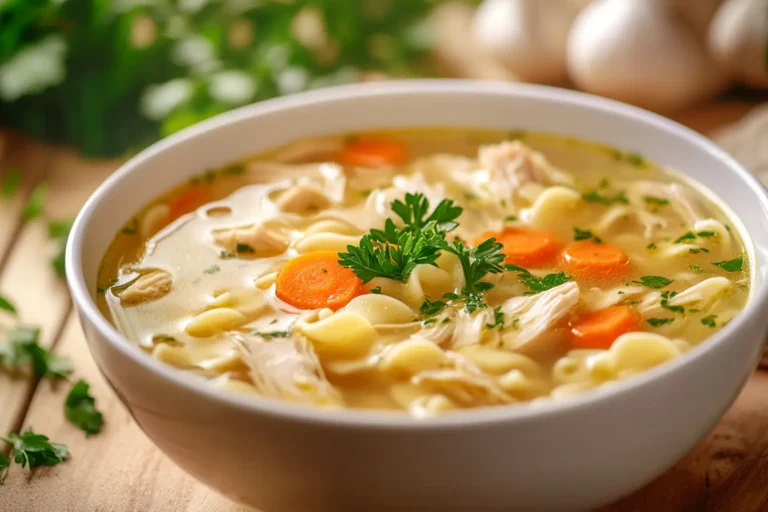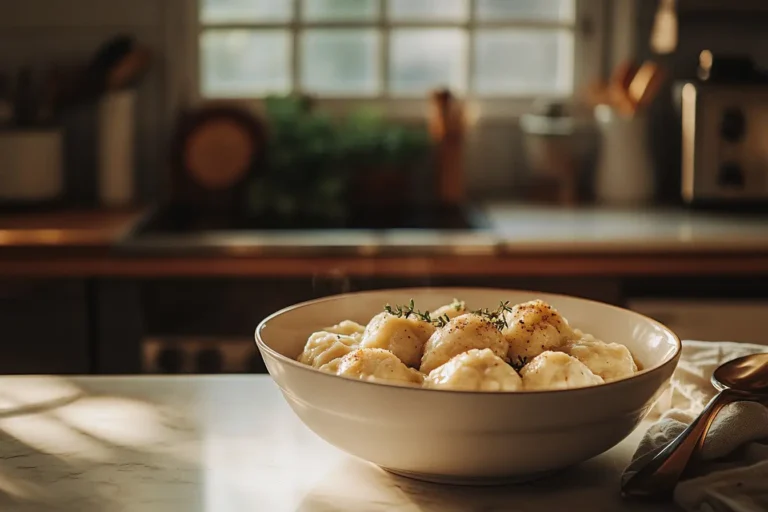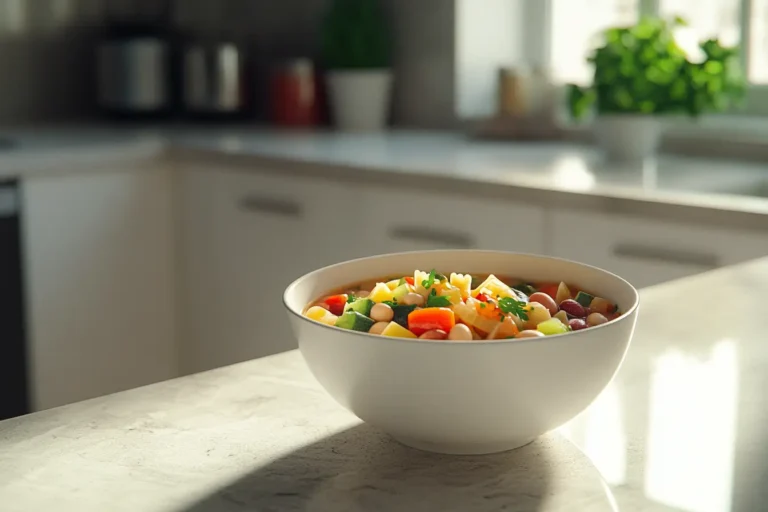The Best Fluffy Pancakes recipe you will fall in love with. Full of tips and tricks to help you make the best pancakes.

Table of Contents
Why Everyone Loves a Hearty Vegetable Soup
If you’re searching for an easy vegetable soup recipe that’s simple, flavorful, and perfect for any occasion, you’ve come to the right place. This dish is the ultimate comfort food, combining hearty vegetables with rich flavors to create a meal that everyone will enjoy. Plus, making a vegetable soup at home is much healthier and tastier than store-bought options. Whether you’re cooking for a family dinner or preparing meals for the week, this easy vegetable soup recipe will quickly become your go-to choice.
“Vegetable soup isn’t just food—it’s a warm hug in a bowl.”
Benefits of Making a Homemade Vegetable Soup
Packed with Nutrition and Flavor
This easy vegetable soup recipe is loaded with fresh, nutrient-dense ingredients like carrots, celery, and spinach. Each spoonful is packed with vitamins, minerals, and natural goodness, making it the perfect addition to your healthy eating plan.. Did you know adding radishes can even boost its health benefits? Their natural zest is the perfect surprise ingredient.
Cost-Effective and Budget-Friendly Meal
Not only is this vegetable soup recipe healthy, but it’s also incredibly cost-effective. With basic ingredients like potatoes, onions, and canned tomatoes, you can create a flavorful dish without breaking the bank. This is an easy vegetable soup recipe you’ll want to make again and again. This is a great addition to quick and easy potluck ideas for large gatherings too.
Perfect for Any Diet: Vegan, Gluten-Free, or Low-Calorie
One of the best things about vegetable soup is its flexibility. It suits nearly any dietary preference. Vegan? Skip the chicken broth. Watching your carbs? Use low-carb vegetables like zucchini or spinach. Everyone gets a dish they can love.
Ingredients for the Perfect Easy Vegetable Soup Recipe
Here’s everything you’ll need to make this simple yet satisfying dish. This easy vegetable soup recipe is flexible, so feel free to swap in your favorite veggies or whatever you have on hand:
| Ingredient | Quantity |
|---|---|
| Carrots | 2, diced |
| Celery | 2 stalks, chopped |
| Onions | 1, diced |
| Potatoes | 2, cubed |
| Vegetable Broth | 6 cups |
| Garlic | 3 cloves, minced |
| Tomatoes | 1 can (14 oz), diced |
| Spinach | 1 cup, fresh |
| Herbs (e.g., thyme, basil) | To taste |
| Salt and Pepper | To taste |
Choosing the Right Vegetables for Your Soup
The beauty of vegetable soup is its adaptability. Use a mix of sturdy vegetables like carrots and potatoes for heartiness, and softer veggies like spinach for added texture. Want more inspiration? Check out this Minestrone Soup recipe for ideas on expanding your veggie game.
Essential Herbs and Spices for a Flavor Boost
Don’t underestimate the power of seasoning! A pinch of thyme, a sprinkle of basil, or a dash of smoked paprika can take your soup to the next level. Add fresh parsley or cilantro for a burst of freshness right before serving.
Broth Options: Vegetable, Chicken, or Beef
The broth you use can make or break your soup. This easy vegetable soup recipe works wonderfully with vegetable broth for a vegetarian option. If you’re not vegetarian, chicken or beef broth can add extra richness. Want a creamy twist? Add a splash of coconut milk to your soup base for added depth.
Step-by-Step Instructions on How to Make Vegetable Soup
Prepping Your Vegetables: Tips and Techniques

Start by washing and chopping all your vegetables. For this easy vegetable soup recipe, it’s important to dice the carrots, celery, and onions into even pieces for a consistent texture. Add harder vegetables like potatoes first since they take longer to cook, and softer greens like spinach at the end.
Sautéing for Enhanced Flavor
Heat a tablespoon of olive oil in a large pot. Add your onions, garlic, and celery. Sauté until fragrant—it’s the start of a flavor-packed base. A simple step, but oh, so important!
Simmering to Perfection: How Long is Enough?
After adding your broth and hearty vegetables, bring the soup to a boil, then reduce the heat to a simmer. Let it cook for about 25-30 minutes or until your vegetables are tender. Pro tip: Don’t overcook! You don’t want your veggies to lose their structure.
Need more ideas for hearty soup options? Try this Vegan Hunter’s Stew for another delicious option.

Common Problems and Solutions When Making Vegetable Soup
Why Is My Soup Bland? How to Fix It
Bland soup can feel like a letdown, but it’s an easy fix! Often, the problem lies in under-seasoning. Start with salt and pepper—these are your flavor foundations. Add a splash of lemon juice or a pinch of red pepper flakes to brighten the flavor. If it still feels flat, try tossing in a bay leaf or fresh herbs while simmering.
“When in doubt, a squeeze of lemon or a touch of vinegar can work wonders to wake up flavors!”
Overcooked Vegetables: Prevention and Remedies
Nothing ruins a soup like mushy veggies. To avoid this, add harder vegetables like carrots and potatoes at the start of the simmering process, and softer greens like spinach or zucchini toward the end. If you’ve already overcooked your veggies, don’t panic—just blend part of the soup for a creamy texture.
Adjusting Consistency: Too Thick or Too Thin?
If your soup is too thick, simply add more broth or water and stir well. On the other hand, if it’s too thin, mix in some mashed potatoes, a spoonful of flour, or blend a portion of the soup to thicken it. This trick works like a charm!
Tips for Customizing Your Vegetable Soup Recipe
Adding Protein: Beans, Lentils, or Meat
Want to make your soup more filling? Toss in some cooked beans like cannellini or chickpeas. Lentils are another excellent option—they cook quickly and add a hearty bite. For meat lovers, shredded chicken or diced beef works beautifully.
Making It Creamy Without Heavy Cream
You don’t need heavy cream to make a creamy soup. Blend a portion of the soup and stir it back in for a luscious texture. You can also add coconut milk or a dollop of plain yogurt for a creamy, dairy-free option.
How to Incorporate Seasonal Vegetables
Embrace the seasons! In summer, zucchini, tomatoes, and corn are fantastic additions. During fall or winter, root vegetables like parsnips, sweet potatoes, and turnips shine. For more seasonal soup inspiration, check out this Minestrone Soup recipe.
Serving Suggestions for a Perfect Soup Meal
Pairing with Bread, Salad, or Other Sides
A bowl of soup is comforting on its own, but pairing it with crusty bread or a fresh salad takes it to another level. Try a garlic baguette, cheesy biscuits, or a simple green salad for the perfect sidekick. Looking for something unique? A slice of green bean casserole complements vegetable soup beautifully.
Garnishes to Elevate the Presentation
Never underestimate the power of a good garnish. A sprinkle of fresh parsley, grated Parmesan, or a drizzle of olive oil adds both flavor and visual appeal. Feeling adventurous? Try roasted pumpkin seeds or a swirl of pesto for that chef’s kiss.
Storing and Reheating Your Vegetable Soup
Best Practices for Freezing Soup
Vegetable soup freezes exceptionally well, making it a great option for meal prep. Let the soup cool completely before transferring it into airtight containers or freezer bags. Remember to leave some space for expansion. Label and date your containers for easy reference!
How to Reheat Without Losing Flavor or Texture
When reheating, avoid boiling the soup to prevent overcooking the veggies. Instead, warm it gently over low heat, stirring occasionally. If the soup thickens too much in the freezer, simply add a splash of broth or water while reheating to restore its consistency.
Why This Recipe Is Perfect for Meal Prep Enthusiasts
Easy to Portion and Store
Whether you’re preparing lunches for the week or stocking up your freezer, this soup is a meal prep hero. It’s easy to portion into individual servings, making it a lifesaver for busy weekdays.
Versatile for Multiple Meals
You can enjoy it as-is, or use it as a base for other meals. Add rice or noodles for variety, or top it with shredded cheese and croutons for a fresh twist. With so many possibilities, this soup never gets boring!
Frequently Asked Questions About Vegetable Soup
What Thickens Vegetable Soup?
There are many ways to thicken vegetable soup without compromising its flavor. You can blend a portion of the soup to create a creamy base, add a handful of cooked rice or lentils, or use a cornstarch or flour slurry. Another great option? Mashed potatoes—they’re a natural thickener and add a deliciously hearty texture.
What Vegetables Go First in a Soup?
The rule of thumb is to add vegetables in the order of their cooking time. Hard vegetables like carrots, potatoes, and parsnips should go in first since they take longer to cook. Softer vegetables like zucchini, spinach, or tomatoes should be added closer to the end to avoid overcooking.
What Is the Secret Ingredient in Soup?
The secret ingredient? It’s umami! Adding a splash of soy sauce, a Parmesan rind, or even a bit of miso paste can take your soup’s flavor to the next level. These ingredients add depth and complexity, leaving everyone wondering what your secret is.
“A Parmesan rind is like the magic wand of soups—instant depth and flavor with no extra effort!”
What Not to Do When Making Soup?
Avoid these common soup mistakes:
- Overcrowding the pot: Give your ingredients room to simmer; overcrowding can dilute flavors.
- Overcooking vegetables: This can turn your soup mushy and unappetizing.
- Skipping the seasoning: Always taste and adjust as you cook. Soup needs layers of flavor!
- Adding cream too early: If using cream, stir it in at the very end to prevent curdling.
The Joy of a Hearty and Easy Vegetable Soup
There you have it—a complete guide to making a vegetable soup everyone will love. This recipe is simple, customizable, and packed with flavor. Whether you’re meal-prepping for the week, serving it at a family dinner, or just enjoying a cozy bowl on your own, this hearty vegetable soup is guaranteed to hit the spot.
Looking for more recipes to try? This Minestrone Soup and Vegan Hunter’s Stew are perfect for adding variety to your soup repertoire. Happy cooking!








